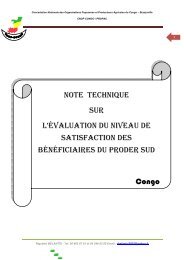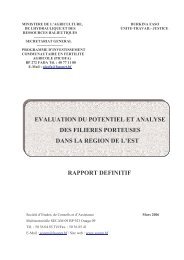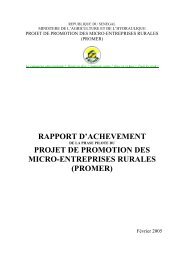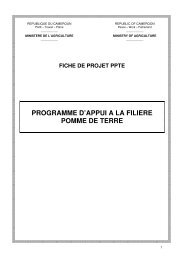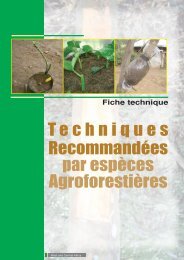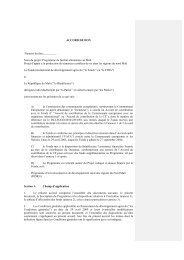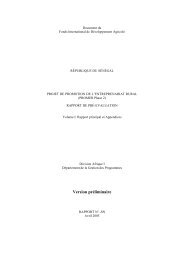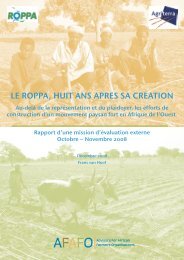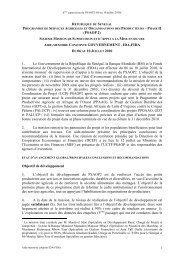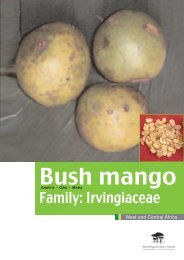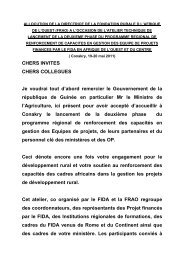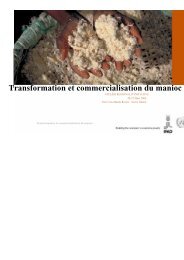Scaling Up the Fight Against Rural Poverty - FIDAfrique
Scaling Up the Fight Against Rural Poverty - FIDAfrique
Scaling Up the Fight Against Rural Poverty - FIDAfrique
You also want an ePaper? Increase the reach of your titles
YUMPU automatically turns print PDFs into web optimized ePapers that Google loves.
preparation, implementation and completion. If IFAD is to translate its strategic intention to scale up<br />
its successful interventions, <strong>the</strong>n it will have to change from a project to a programmatic approach and<br />
COSOPs will need to address scaling up objectives, approaches and support processes in significantly<br />
greater depth than is presently <strong>the</strong> case, similar to <strong>the</strong> case of Peru. Most importantly, <strong>the</strong> scaling up<br />
pathway with its various dimensions and components needs to be recognized, laid out and managed.<br />
COSOPs are also <strong>the</strong> place where <strong>the</strong> links between innovation, learning and scaling up can be clearly<br />
articulated and possible tensions between <strong>the</strong>se operational goals can be addressed transparently. This<br />
process of articulation will help to build and implement a vision for IFAD’s country programs. It will<br />
also help to mobilize in-country support of <strong>the</strong> government and o<strong>the</strong>r stakeholders for <strong>the</strong> process.<br />
Two steps will help in turning <strong>the</strong> COSOP into an effective instrument for scaling up:<br />
A clear link needs to be articulated between scaling up and <strong>the</strong> COSOP results matrix:<br />
COSOPs now are built around a results management matrix. In future scaling up objectives<br />
would need to be connected to <strong>the</strong> results objectives and indicators laid out in <strong>the</strong> matrix. For<br />
example, if certain targets for rural poverty reduction, agricultural production increases or<br />
natural resource conservation are included in <strong>the</strong> results matrix, <strong>the</strong>n scaling-up pathways need<br />
to be laid out to demonstrate how through scaling up indicated objectives could be achieved.<br />
The design of specific projects <strong>the</strong>n needs to demonstrate that <strong>the</strong>y will contribute to <strong>the</strong><br />
achievement of <strong>the</strong> targets laid out in <strong>the</strong> COSOP results matrix as part of a specified scaling<br />
up pathway.<br />
For COSOPs to become strategic documents for scaling up, <strong>the</strong> review processes needs to<br />
focus on strategic questions, including <strong>the</strong> following:<br />
(i) what does IFAD wish to achieve through its programme in <strong>the</strong> country and at what<br />
scale;<br />
(ii) does it have <strong>the</strong> right mix between innovation and scaling-up;<br />
(iii) what kind of scaling up is anticipated, by whom, how;<br />
(iv) how will IFAD help support to achieve this scaling up;<br />
(v) does <strong>the</strong> COSOP provide for <strong>the</strong> appropriate instruments to allow this to happen;<br />
(vi) how will new projects that will be approved through <strong>the</strong> COSOP contribute to <strong>the</strong><br />
results objectives and indicators laid out in <strong>the</strong> results management matrix; and<br />
(vii) through what pathway and over what time frame could this be achieved?<br />
C. IFAD’s Project Cycle: Project Design and Implementation<br />
As for o<strong>the</strong>r development institutions, IFAD’s operational processes are aligned with a project cycle.<br />
This project cycle consist of (i) concept approval; (ii) design stage; (iii) appraisal; (iv) negotiations and<br />
Board presentation; (iv) implementation; and (v) completion. Again, <strong>the</strong> question arises how scaling<br />
up is considered at <strong>the</strong> various stages of <strong>the</strong> project cycle.<br />
1. The project design phase<br />
Projects are introduced into <strong>the</strong> design phase ei<strong>the</strong>r through a concept note, approved by <strong>the</strong> OSC, or<br />
through approval of a Results Based COSOP, which presents short versions of applicable project<br />
concept notes in its annex. Through approval of <strong>the</strong> Results Based COSOP, <strong>the</strong> projects presented in<br />
its annexes are also cleared for proceeding to <strong>the</strong> design stage. The first mission in <strong>the</strong> project cycle is<br />
<strong>the</strong> so-called “formulation mission”. Based on this mission a “formulation report” is prepared. The<br />
project document report remains in formulation stage until a Quality Enhancement (QE) review has<br />
taken place and an appraisal mission has been completed. The project design phase is completed with<br />
<strong>the</strong> appraisal mission and <strong>the</strong> formulation report is transformed into a “project design report”.<br />
Subsequent to <strong>the</strong> appraisal mission, a Quality Assurance (QA) review is conducted, subject to which<br />
projects are authorized to proceed to negotiations and subsequent Board approval. While IFAD project<br />
30



